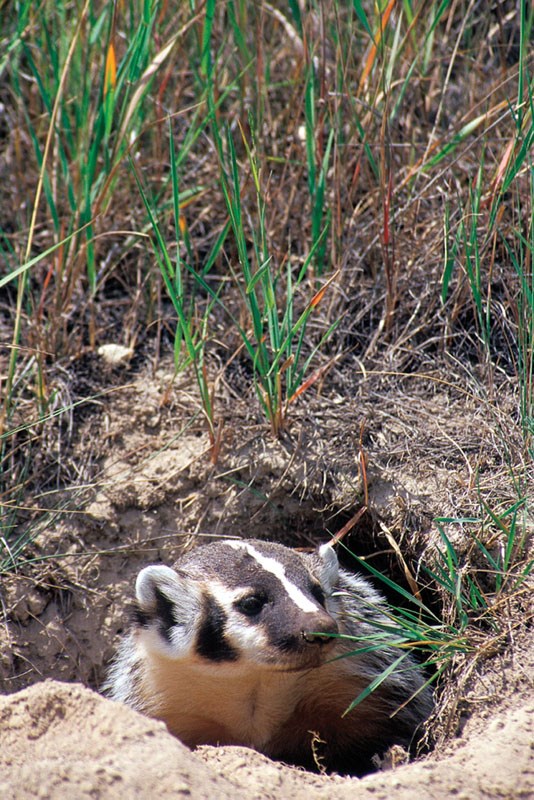An endangered population of badgers in the Columbia Valley and surrounding Kootenay region has dropped to as few as 100 mature individuals and remains on the brink of extinction.
The Committee on the Status of Endangered Wildlife in Canada (COSEWIC) assessed the eastern population (jeffersonii subspecies) as endangered. Road mortality, habitat loss and urban development continue to threaten badgers.
Scientists say there are between 100 and 160 breeding individuals in that population, noting that when populations dip that low, populations can seldom recover without human intervention.
“When you get a pretty large animal getting down to numbers in the hundreds, it’s quite a concern,” said Dr. Graham Forbes, co-chair of COSEWIC’s terrestrial mammals sub-committee.
“It does not take too many events to take out breeding animals. If there were 1,000 that would be a concern, but the fact it’s 100 to 160 is very troubling.”
Badgers belong to the weasel family and are related to mink, marten and wolverine. Spending much of their life underground, badgers are sensitive animals and rarely seen.
The species that lives in Canada is the American badger. In neighbouring B.C., remnant badger populations are limited to the south-central and southeast portions of the province.
In the early 1900s there was widespread persecution of badgers – they were relentlessly shot, trapped and poisoned – and most populations never recovered.
But today, other threats such as urban development, death on roads and highways, as well as forest overgrowth from years of fire suppression are equally as threatening to the survival of badgers into the future.
Scientists have previously said recovery of badgers in B.C. is feasible, but the challenge lies in mitigating road mortality, maintaining large tracts of well-connected high quality habitat and eliminating the killing of badgers.
In the last decade, there have been badger surveys and radio-tag projects, as well as relocation of badgers from less stressed populations, including from Montana in United States.
“They face major problems throughout their range in B.C.,” said Forbes.
In Kootenay National Park, there has been an average of about one badger sighting a year over the past decade, but remote motion-triggered cameras near Redstreak campground have captured images of two badgers in recent times.
Most of the sightings in Kootenay National Park have been in the southwest corner of the park, mainly in the area of Redstreak Campground and Radium Hot Springs.
“The park is really quite a small area of potential badger habitat,” said Alan Dibb, a Parks Canada wildlife specialist and a member of the 2001 badger recovery team.
“As far as we know, there are no resident badgers, but we have some that are mostly resident on provincial and private lands that may occasionally use the habitat in the park.”
In the East Kootenay region, the American badger’s favourite food is the Columbian ground squirrel, but they also eat voles, sparrows, loons, fish and even beetles.
A restoration project in the Redstreak area of Kootenay National Park – which primarily targeted habitat improvement for bighorn sheep – had wildlife specialists hoping to see a return of ground squirrels.
“We were quite interested in whether the forest clearing and restoration of grasslands would result in colonization of the area by ground squirrels,” said Dibb.
“We have monitored that area for a possible increase in ground squirrels, but so far we haven’t seen that take place.”
The eastern badger population found in the Columbia Valley and East Kootenay region is now considered a separate population to the western population of the Okanagan-Cariboo region, which is said to have fewer than 250 mature badgers.
This decision was made by COSEWIC at its meeting in November.
“There’s genetic differences and we no longer believe there’s any movement between the two populations because of the Selkirk Mountains,” said Forbes.
“I suspect there’s always been a significant barrier because of the habitat, but it is possible in the past there was more of a connection down through the U.S.”
COSEWIC assessed 42 Canadian wildlife species as at risk at its November meeting and found that expanding road networks are harmful to many endangered species, from rattlesnakes, to toads, salamanders and badgers.
Forbes, a member of the faculty of forest and environmental management at the University of New Brunswick, said badgers require open habitat with soils that can be dug into stable burrows.
He said suitable habitat patches are now often found near roadways, which pose a significant threat to badgers.
“With increased road building and increased traffic levels there’s been increased mortality rates and that seems to be a major problem across their range,” he said.




